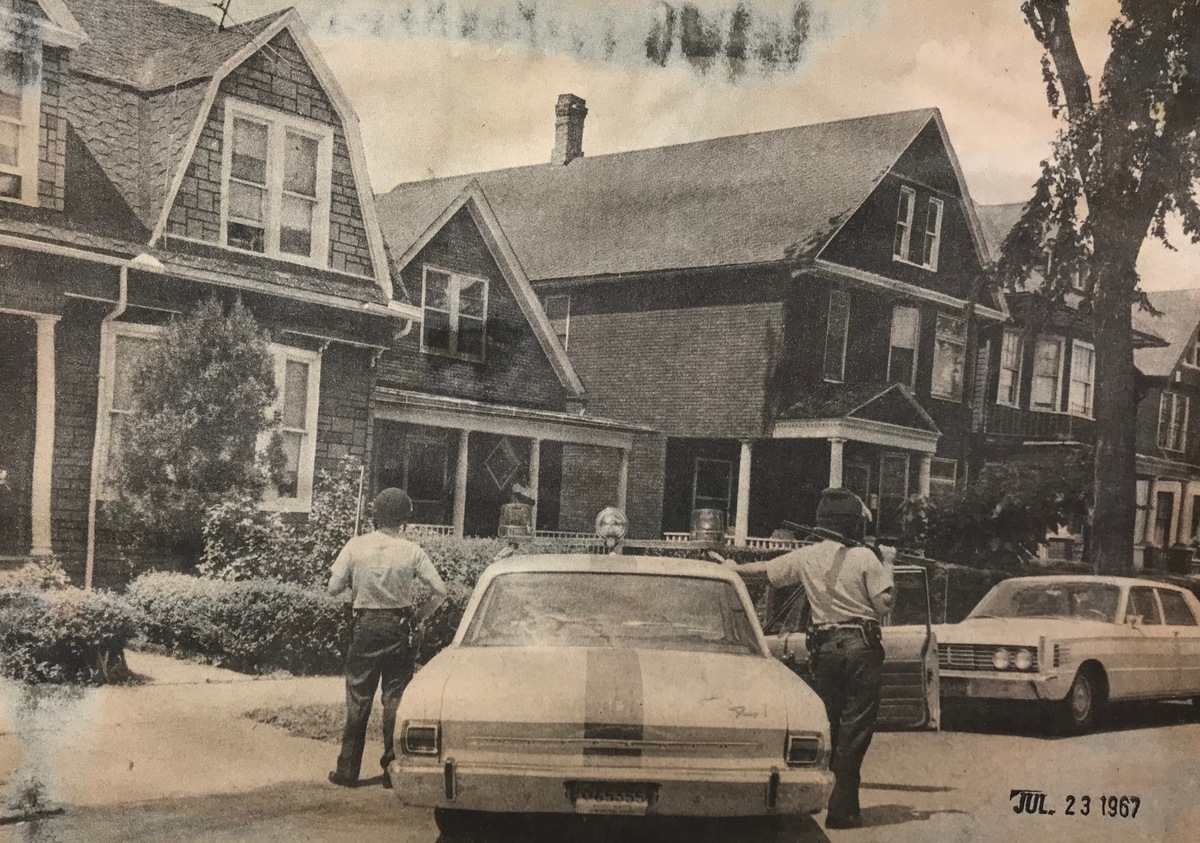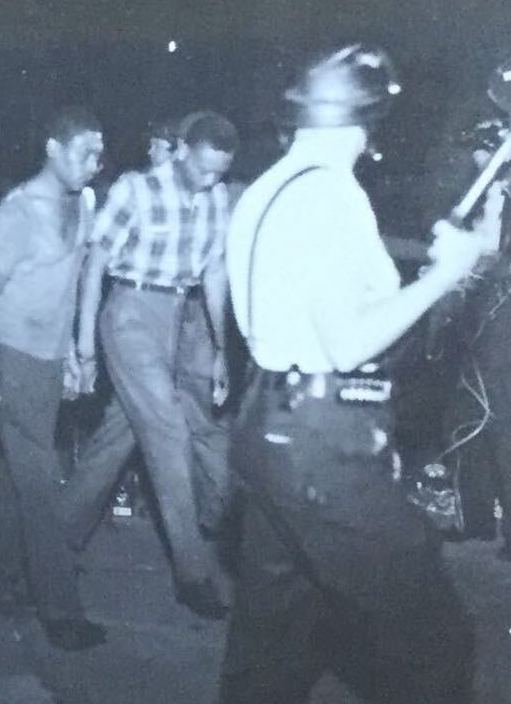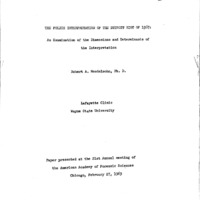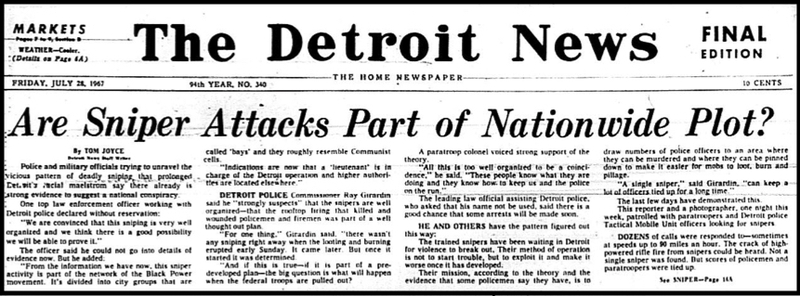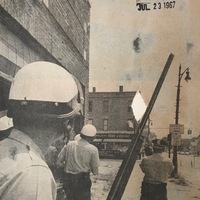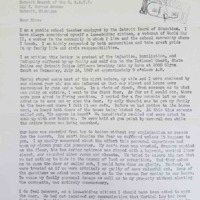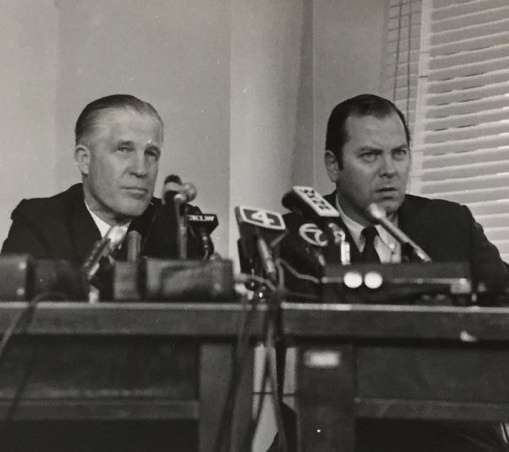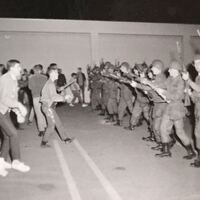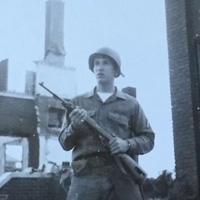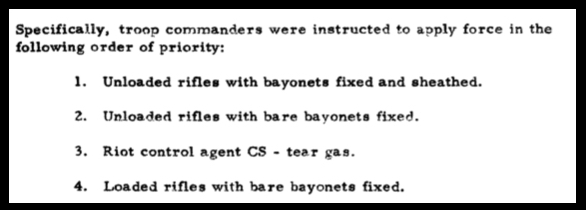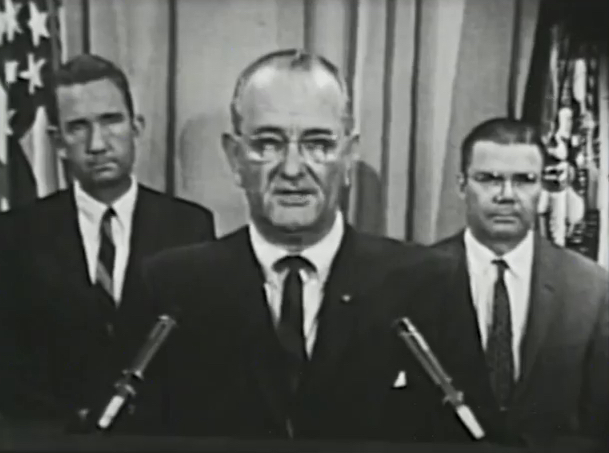Occupying the City
State of Emergency
Around 17,000 law enforcement officers and military troops occupied and patrolled the city of Detroit, and more specifically the African American sections and downtown business district of Detroit, during the six-day Uprising from July 23-28, 1967. These included:
- Detroit Police Department (riot police, uniformed officers, patrolmen, and undercover units)
- Michigan State Police (a majority of the statewide force)
- Michigan National Guard, 46th Infantry Division (around 8,000 troops)
- U.S. Army, 82nd and 101st Airborne Divisions (around 5,000 troops)
Almost all of the law enforcement and military troops were white men. Almost all of the civilians whom they killed, shot at, arrested, and otherwise sought to pacify and control were African Americans, in particular male teenagers and young adults. The DPD was 92% white in 1967, and the National Guard division was 99% white. The Michigan State police force was 100% white. Only the U.S. Army divisions were significantly integrated: about one-fourth of the paratroopers were African Americans.
Even more important, the different agencies and units operated under different use of force orders during a declared state of emergency with a citywide curfew. The Cavanagh administration and DPD hierarchy informed its officers to "use discretion" and "professional judgment" in deciding whether to shoot looters, and the city's police force killed at least 22 people and wounded and brutalized far more. Despite mass arrests and high levels of police violence, especially on the second and third days, the DPD proved unable to contain the civil unrest without military reinforcements.
The Michigan National Guard division, which consisted mainly of young and inexperienced white men from rural and suburban areas, deployed with orders to "shoot any person seen looting." National Guardsmen killed at least eleven people and, according to many reports, often fired wildly at imagined "snipers" and in the process shot at not only civilians but also other law enforcement units, or at one another, by accident. The Michigan State Police only killed one person (that our project has identified so far), likely because its personnel largely withdrew to patrol other Michigan cities after the military arrived.
The U.S. Army paratroopers operated under orders to use "minimum force" and played a key role in quelling the Uprising and stabilizing the civil unrest in the city without resorting to the extreme and often indiscriminate violence of the DPD and National Guard. The Army troops even patrolled with unloaded weapons and were under force escalation instructions to use tear gas before they loaded their rifles to fire on anyone.
Detroit Police Department: An "Occupying Force"
The DPD was a 92% white department in a city with a 40% black population in 1967, as white residents continued to move to the suburbs rather than live in integrated neighborhoods. The DPD's rank-and-file officers were mostly working-class white men who shared the political and racial outlook of their counterparts in the general white population. Many African American residents viewed the DPD as an "occupying force," as Isaiah (Ike) McKinnon, an African American military veteran who joined the department in 1965, explains looking back.
The DPD's precinct-level commanders and its officers on the street had largely resisted the Cavanagh administration's many promises of liberal reform and community-oriented policing, while pushing for and embracing the mayor's get-tough, militarized approach that accelerated with the war on crime and rise of black power in the mid-1960s. In the field, DPD officers operated with near impunity, emboldened by policies that formalized discretionary policing, allowing them to arrest almost anyone for almost any reason, and fully aware that brutality and misconduct against African American citizens would rarely even be investigated thoroughly and would almost never result in punishment of any kind.
Multiple studies revealed that the average white DPD officer was overtly hostile toward African Americans, broadly stereotyping lower-income black residents in particular as "criminals," and equating civil rights activism with agitation by violent "militants." In a survey conducted soon after the "riot" ended (see right), three-quarters of rank-and-file white patrolmen believed that the 1967 civil unrest had been "planned in advance" by black power radicals (the majority of upper-level DPD officers did not share this view). The survey also revealed that white DPD officers overwhelmingly disagreed that the black community faced any racial discrimination, and that many believed that social policies actually favored African Americans over white people. The study concluded:
DPD violence and brutality, mostly against unarmed African American civilians, resulted from the city's government's and police department's policies as well as the racial attitudes of individual officers and the culture of the force as a whole. Unlike Governor Romney, Mayor Cavanagh hesitated in terms of explicitly endorsing the threat of deadly force against looters, but he also made clear that individual DPD officers had the discretion to make their own decisions, leading to the understanding at street level that it was "all right to open fire." On July 24, Cavanagh stated: "at no time was an order issued that police were not to use weapons available to them." (This convoluted double negative appears to be an effort by the mayor to authorize use of deadly force without taking responsibility for the resulting fatalities).
Wild rumors of snipers also exacerbated the already tense and violent situation, as promoted by law enforcement and the National Guard, and hyped by the often irresponsible mainstream media. On July 28, for just one example, the Detroit News provided an uncritical platform for the unfounded claims of law enforcement officials that "this sniper activity is part of the network of the Black Power movement" and "very well organized" (right). Police Commissioner Ray Girardin endorsed this conspiracy theory as well. The Detroit News even conveyed the DPD's warning that its officers faced a guerilla insurgency with the mission "to draw numbers of police officers to an area where they can be murdered and where they can be pinned down to make it easier for mobs to loot, burn, and pillage."
It should not be surprising, therefore, that a majority of white residents of Detroit and its suburbs also considered the civil unrest to be a conspiracy of violent black militants. The Detroit Police Department was an extension of, not a deviation from, majority white sentiment that opposed a civilian review board, demanded stop-and-frisk policing of Black Detroit, and endorsed police violence against "looters" and "rioters."
While there probably were some individual cases of gunfire aimed at law enforcement, this highly organized nationwide "sniper attacks" framework was a dangerous myth and indeed a white racial fantasy. As the Kerner Commission documented, the alarm about snipers promoted by police and the news media was "highly exaggerated," and in most cases law enforcement mistook gunshots by other law enforcement units as sniper fire. The main threat to the lives of DPD officers and National Guardsmen came from other police officers and Guardsmen who were firing wildly in fear and panic of sniper attacks. And the only documented cases of cold-blooded, premeditated murder involving law enforcement were committed by white DPD officers themselves.
DPD officers also raided many private homes and conducted countless searches on the streets in pursuit of "snipers" and "looters." Many, perhaps most, DPD officers also removed their badges and other identifying information during the Uprising, which meant that they were able to operate with the impunity of expecting not to be held individually accountable. These operations brought an avalanche of allegations of police brutality from African American residents of Detroit. While the white newspapers largely presented the "riot" from the perspective of the police, the Michigan Chronicle, Detroit's main African American weekly, adopted a much more critical stance and labeled many DPD actions obviously unconstitutional. The Chronicle's coverage pointed out that raids of entire neighborhoods without search warrants or probable cause were illegal and quoted an attorney who emphasized that the police "have no right to search each and every home unless they have reasonable grounds to suspect that stolen goods are in each and every house."
The experience of Charles Estus and his family provides a typical example of life in Detroit's black community under a legal state of emergency that functioned as the illegal equivalent of martial law. He told the story in a letter (right) sent to the NAACP, Mayor Cavanagh, and Governor Romney, among others, to protest "the injustice, humility, and indignity suffered by my family." Estus was a public school teacher and a self-described "law-abiding citizen." On July 26, at 9:00 a.m., his 11-year-old son sounded the alarm that a tank and men with guns drawn were outside their house. Without any warning, they kicked in the door and held Estus and his family at gunpoint. An assortment of officers from the DPD and the Michigan State Police, joined by National Guardsmen, searched his house "from top to bottom" and damaged his property and possessions extensively. They provided no explanation and answered no questions about what they were doing or why. They left without apology. "You can't imagine the fear we suffered," Estes wrote, "unless it happens to you." He continued:
Isaiah (Ike) McKinnon, a retired DPD officer, tells a story of his experience as an African American man during the 1967 Uprising that is a revealing example of the extreme violence and danger that members of the black community faced during these six days in July. When McKinnon, as quoted above, referred to his own department as an "occupying force" in Detroit's black neighborhoods, he meant that many African Americans felt this way not just during the Uprising, but as a permanent condition of police-community relations during the 1950s and 1960s (for context, see McKinnon's story of his unprovoked beating by police as a teenager in 1957). On July 23, the first day of the Uprising, McKinnon was driving home after working a 16-hour shift when white officers pulled him over with their guns drawn. He was still wearing his police uniform, but they only saw a black man behind the wheel. One of the white officers said, "tonight, you're going to die, n-----," and started firing. McKinnon jumped back into his car and sped away, barely escaping with his life. When he made it home, he called his sergeant to report the incident, but there was no investigation and nothing happened.
Isaiah McKinnon's Experience on July 23, 1967 (2 min.)
Michigan National Guard: Unjustified Violence
Governor George Romney deployed the Michigan National Guard on the afternoon of July 23, barely twelve hours after the raid on the blind pig, at the request of Mayor Jerome Cavanagh and with the support of Detroit's traditional black leadership.Michigan National Guard: Unjustified Violence
The Michigan National Guard division escalated the violence without contributing to the solution. Many of its members behaved deplorably, but the responsibility for this was institutional. The 46th Infantry Division, as described above, was almost completely white and deployed with orders to defend property and "shoot any person seen looting." National Guardsmen were responsible for the fatalities of at least eleven people, and likely more. Very few of these killings, if any, appear justified, even under the initially very permissive use of force orders. When President Johnson sent in the U.S. Army, late in the evening of July 24, he also federalized the National Guard. Despite this new chain of command, many National Guardsmen either refused to comply with, or perhaps in some cases did not receive, the Army orders to use "minimum force" and not to shoot unarmed people.
All four of the fatalities of African American men on the East Side of Detroit attributed to the National Guard appear unjustified. "Jittery" and "trigger-happy" Guardsmen mistakenly shot and killed a private security guard who was defending a store; a man who stopped as instructed at a checkpoint; a man walking to work whom they misclassified as a looter in a cover-up attempt; and a man in a car whose occupants described the sudden gunfire as an "ambush."
The only armed person killed by a National Guardsman was a white man who lived in a racially transitional area near downtown and was defending his property and mistaken for a sniper.
The other five fatalities by National Guardsmen include a 51-year-old white woman mistaken for a sniper; a white National Guardsman killed accidentally by members of his own unit, who then sought to frame three black teenagers; an unarmed African American man killed inside his home during a sniper hunt, also framed in an attempted cover-up; a 20-year-old African American man shot without cause while walking down the street; and a 4-year-old African American girl killed by a tank unit inside her own home.
For this death of 4-year-old Tonia Blanding, the Michigan National Guard commissioned an investigation to justify the use of deadly force against a black family huddled in fear inside their apartment in the middle of the night, based on the "reasonable" fear that the Guardsmen were under sniper fire. The report provides a clear example of how the National Guard perceived its occupation of Black Detroit as the equivalent of a war zone. The official statement recounts the actions of the the tank commander, a 41-year-old white man who served in combat in World War II, in this way:
National Guardsmen shot a number of other people, non-fatally, and fired often and wildly at alleged and imagined snipers. In one incident, a Guardsman turned and shot another Guardsman because he "stepped on a tin can, thereby making a loud noise." It is perhaps surprising that the National Guard did not kill more people, given the obvious indiscipine and the initially permissive use of force authorization. At the same time, the Department of Defense explicitly found that many National Guardsmen did not follow the Army's orders to unload their weapons and use minimum force (right) after they came under federal control from July 25 onward. After the Uprising ended, the commander of the National Guard, Major General Cecil Simmons, told the Kerner Commission that the snipers were "not organized but entirely sporadic" and that probably only a few snipers, maybe around seven, were involved.
National Guardsmen also joined DPD officers in home invasions and committed a number of acts of brutality against residents of Detroit. Also see the Staging Military Occupation page later in this section for a selection of photographs from the Michigan National Guard's public relations operation, showing young white Guardsmen posing for the cameras in various devastated and occupied black neighborhoods and commercial districts in Detroit, as if they are armed tourists in a foreign war zone.
U.S. Army: Military Occupation of Black Detroit
President Lyndon Johnson ordered 5,000 U.S. Army paratroopers to deploy to the city of Detroit late in the evening of July 24, the second day of the Uprising. The two U.S. Army divisions patrolled the African American neighborhoods on the East Side of Detroit, leaving the West Side, where the Uprising had begun, to the Michigan National Guard and the DPD.
Governor Romney and Mayor Cavanagh had first requested the intervention of the U.S. military almost 24 hours earlier, at 3:00 a.m. Their request had the support of a broad cross-section of the mainstream African American leadership in Detroit, including Congressman Charles Diggs, Jr.; Judge Damon Keith, the head of the Michigan Civil Rights Commission; and influential ministers (black power leaders such as Rev. Albert Cleage were not consulted). The Johnson administration initially responded that federal troops were not needed, and then required Governor Romney to seek written permission and publicly admit that he had lost control. This was a political calculation by the Democratic adminstration, designed to place responsibility for the military occupation of a U.S. city on local and state officials, especially the Republican governor.
In late morning on July 24, Romney sent the president a telegram requesting federal intervention immediately and stating:
President Johnson announced the military intervention in a nationally televised address close to midnight, after Cyrus Vance, his delegate in Detroit, had assured him that local law enforcement had been overwhelmed. Johnson portrayed the civil unrest as criminal activity, unrelated to the movement for racial justice, and said nothing about police brutality or any other root causes. The president told the nation:
- "Law and order have broken down in Detroit, Michigan"
- "Pillage, looting, murder, and arson have nothing to do with civil rights. They are criminal conduct."
- "We will not tolerate lawlessness. We will not endure violence. It matters not by whom it is done or under what slogan or banner. It will not be tolerated. This Nation will do whatever it is necessary to do to suppress and to punish those who engage in it."
President Johnson also sought to make clear that the overwhelming majority of African Americans, as well as white Americans, opposed what was happening in Detroit and also what had happened so recently in Newark.
- "I know that with few exceptions the people of Detroit, and the people of Newark, and the people of Harlem, and of all of our American cities, however troubled they may be, deplore and condemn these criminal acts. I know that the vast majority of Negroes and whites are shocked and outraged by them."
- "Your President calls upon all of our people, in all of our cities, to join in a determined program to maintain law and order--to condemn and to combat lawlessness in all of its forms--and firmly to show by word and by deed that riots, looting, and public disorder will just not be tolerated."
- "I call upon the people of the ravaged areas to return to their homes, to leave the streets, and to permit the authorities to restore quiet and order without further loss of life or property damage. Once this is done, attention can immediately be turned to the great and urgent problems of repairing the damage that has been done."
Watch President Johnson's address below, and read the full address above right.
Lyndon B. Johnson, "Remarks to the Nation After Authorizing the Use
of Federal Troops in Detroit," July 24, 1967
Sources:
Department of Civil Rights, Community Relations Bureau, RG 83-55, Michigan State Archives, Lansing, Michigan
George Romney Papers, Bentley Historical Library. University of Michigan
Sidney Fine Collected Research Materials, Bentley Historical Library, University of Michigan
Michigan Chronicle, August 12, 1967
Detroit News, July 28, 1967
Charles William Ungermann Papers, Bentley Historical Library, University of Michigan
Jerome P. Cavanagh Papers, Walter P. Reuther Library. Wayne State University
NAACP Detroit Branch Records, Walter P. Reuther Library, Archives of Labor and Urban Affairs, Wayne State University
Civil Rights during the Johnson Administration, 1963-1969, Part V: Records of the National Advisory Commission on Civil Disorders (Kerner Commission), Lyndon Baines Johnson Presidential Library, Austin Texas (ProQuest History Vault)
Report of the National Advisory Commission on Civil Disorders, March 1968 (Washington: GPO, 1968), National Criminal Justice Reference Service
Kerner Commission Investigative Staff, "Detroit, Michigan: Description of Area and Chronology of Disorder of July 23-August 2, 1967," Folder 001346-008-0104, Civil Rights during the Johnson Administration, 1963-1969, Part V: Records of the National Advisory Commission on Civil Disorders (Kerner Commission), Lyndon Baines Johnson Presidential Library, Austin Texas (ProQuest History Vault)
General Photographic Collection, Michigan State Archives, Lansing, Michigan
President Lyndon Johnson, "Address on Civil Disorder," July 24, 1967, https://www.c-span.org/video/?431147-2/president-johnson-address-civil-disorder
HBO, A City on Fire (2002)
Isaiah (Ike) McKinnon Interview, Part 1, December 3, 2019, https://lsa-dss.mivideo.it.umich.edu/media/t/1_rxtil0md/145739741
Sidney Fine, Violence in the Model City: The Cavanagh Administration, Race Relations, and the Detroit Riot of 1967 (Lansing: Michigan University Press, 2007)
Joel Stone, ed., Detroit 1967: Origins, Impacts, Legacies (2017)
Hubert G. Locke, The Detroit Riot of 1967 (1969, reissued 2017)

